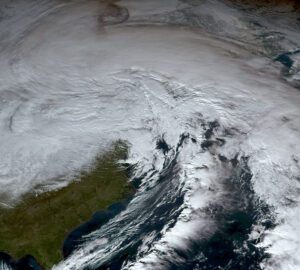
As we know from the news, the extratropical cyclone, aka “Elliot,” created truly historic winter storm conditions across most of the United States and parts of Canada. In light of the havoc the storm wreaked, we thought this might be a good time to help everyone be sure their bucket truck and crew are ready for rest of the winter.
OSHA does not have a specific standard that covers working in cold environments, but their website offers an overview of winter preparedness which includes a“Cold Stress Guide.” Per OSHA, it is important for employers to know the wind chill temperature so that they can gauge workers’ exposure risk better and plan how to safely do the work. For example, at 40 degrees Fahrenheit and winds of 35 mph, the effect on exposed skin is as if the air temperature is 28F. At 32F and winds at 20 mph, the wind chill is 17F. Prolonged exposure to cold and windy conditions, regardless of it occurring in winter weather or any time of the year, can result in hypothermia and frostbite.

Besides wind chill and cold stress concerns, windy conditions could cause you to lose control of the tools you’re using, like a tree saw or utility tools. Winds can cause additional tree and wire damage. High winds and snow can cause blizzard and/or white-out conditions making driving very difficult, if not impossible.
As we discussed in our blog “Hydraulic Fluid 101,” bucket truck manufacturers recommend using aviation hydraulic fluid. Cold temperatures can cause your hydraulic oil to thicken making for sluggish operation. So be nice to your hydraulic system in cold conditions. To avoid starving the unit’s pump, run the system at the lowest pump setting for a while to warm it up.

While we’re on the subject, what about warming up your truck engine? For fuel efficiency and environmental reasons, manufacturers recommend minimal warm up time. That’s assuming you own a truck with a fuel injection system, which regulates the fuel/air mixture in the engine. But if you own an older truck that uses a carburetor, you may need to idle for a few minutes, at least until the windshield is defrosted.
And finally, let’s not forget the benefit of facial hair! Yes, its true, beards do indeed help insulate your face from the cold. The beard not only helps hold body heat in, but it can protect against the windchill factor too. We are not certain what the aviator sunglasses do against the winter chill … but man, they sure do look cool!
Utility Equipment Parts does not sell beard trimmers 😆 … but for all your bucket truck and digger derrick parts and accessory needs, the UEP Guys can help. Contact us today.
Stay Warm!

The UEP Guys